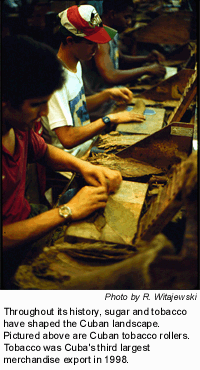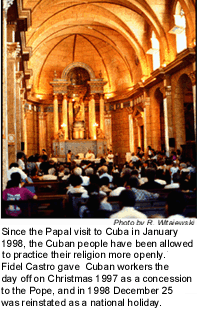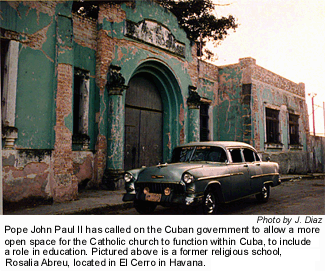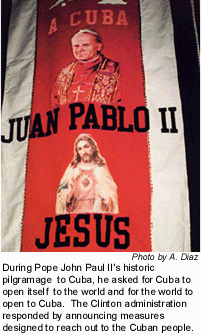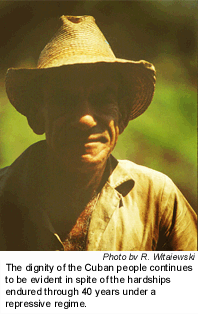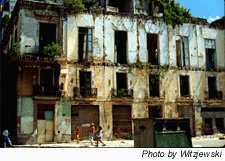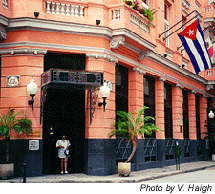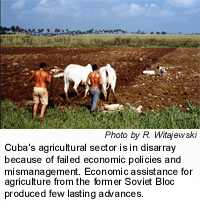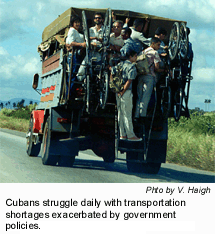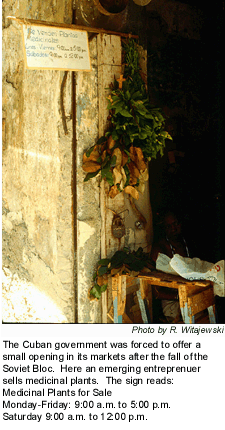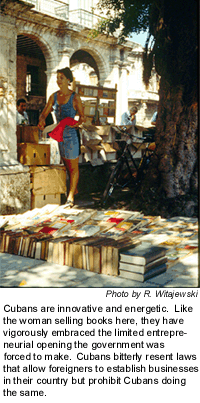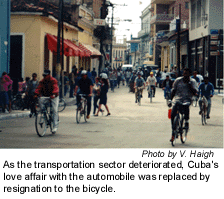Bureau of Western Hemisphere Affairs
September 2002
| Background Note:
Cuba PROFILE
OFFICIAL NAME: People Government Economy PEOPLE AND RELIGION
The Catholic church is the largest independent institution in
Cuba today but continues to operate under significant pressure. The
Cuban Government continues to refuse to allow the church to have
independent printing press capabilities; full access to the media;
to train enough priests for its needs or allow adequate numbers of
foreign priests to work in the country; or to establish socially
useful institutions, including schools and universities, hospitals
and clinics, and nursing homes.
Other Cuban religious groups--including evangelical Christians,
whose numbers are growing rapidly--also have benefited from the
relative relaxation of official restrictions on religious
organizations and activities. Although particularly hard hit by
emigration, Cuba's small Jewish community continues to hold services
in Havana and has pockets of faithful in Santiago, Camaguey, and
other parts of the island. Assistance from Jewish communities
abroad, including arranging for visiting rabbis and rabbinical
students, helps to keep the Hebrew faith alive in Cuba.
Cuba was the last major Spanish colony to gain independence,
following a 50-year struggle begun in 1850. Jose Marti, Cuba's
national hero, began the final push for independence in 1895. In
1898, after the USS Maine sunk in Havana Harbor on February
15 due to an explosion of undetermined origin, the United States
entered the conflict. In December of that year Spain relinquished
control of Cuba to the United States with the Treaty of Paris. On
May 20, 1902, the United States granted Cuba its independence but
retained the right to intervene to preserve Cuban independence and
stability under the Platt Amendment. In 1934, the amendment was
repealed, and the United States and Cuba reaffirmed the 1903
agreement that leased the Guantanamo Bay naval base to the United
States.
Independent Cuba was often ruled by authoritarian political and
military figures who either obtained or remained in power by force.
Fulgencio Batista, an army sergeant, organized a non-commissioned
officer revolt in September 1933 and wielded significant power
behind the scenes until he was elected president in 1940. Batista
was voted out of office in 1944 and did not run in 1948. Both those
elections were won by civilian political figures with the support of
party organizations. Running for president again in 1952, Batista
seized power in a bloodless coup 3 months before the election was to
take place, suspended the balloting, and began ruling by decree.
Many political figures and movements, that wanted a return to the
government according to the Consititution of 1940, disputed
Batista’s undemocratic rule.
Fidel Castro, who had been active politically before Baista's
coup, on July 26, 1953 led a failed attack on the Moncada army
barracks in Santiago de Cuba, was jailed, and subsequently went into
exile in Mexico. There he organized the 26th of July Movement with
the goal of overthrowing Batista, and the group sailed to Cuba on
board the yacht Granma, landing in the eastern part of the island in
December 1956.
Batista's dictatorial rule fueled increasing popular discontent
and the rise of many active urban and rural resistance groups, a
fertile political environment for Castro's 26th of July Movement.
Faced with a corrupt and ineffective military itself dispirited by a
U.S. Government embargo on weapons sales to Cuba and public
indignation and revulsion at his brutality toward opponents, Batista
fled on January 1, 1959. Although he had promised a return to
constitutional rule and democratic elections along with social
reforms, Castro used his control of the military to consolidate his
power by repressing all dissent from his decisions, marginalizing
other resistance figures, and imprisoning or executing opponents. As
the revolution became more radical, hundreds of thousands of Cubans
fled the island.
Castro declared Cuba a socialist state on April 16, 1961. For the
next 30 years, Castro pursued close relations with the Soviet Union
until the demise of the U.S.S.R. in 1991. Relations between the
United States and Cuba deteriorated rapidly as the Cuban regime
expropriated U.S. properties and moved toward adoption of a
one-party communist system. In response, the United States imposed
an embargo on Cuba in October 1960, and, in response to Castro's
provocations, broke diplomatic relations on January 3, 1961.
Tensions between the two governments peaked during the October 1962
missile crisis.
GOVERNMENT According to the Soviet-style Cuban constitution of 1976, the
National Assembly of People's Power, and its Council of State when
the body is not in session, has supreme authority in the Cuban
system. Since the National Assembly meets only twice a year for a
few days each time, the 31-member Council of State wields power. The
Council of Ministers, through its nine-member executive committee,
handles the administration of the economy, which is entirely
state-controlled. Fidel Castro is President of the Council of State
and Council of Ministers and his brother Raul serves as First Vice
President of both bodies as well as Minister of Defense.
Although the constitution theoretically provides for independent
courts, it explicitly subordinates them to the National Assembly and
to the Council of State. The People's Supreme Court is the highest
judicial body. Due process is routinely denied to Cuban citizens,
particularly in cases involving political offenses. The constitution
states that all legally recognized civil liberties can be denied to
anyone who opposes the "decision of the Cuban people to build
socialism." Citizens can be and are jailed for terms of 3 years or
more for simply criticizing the communist system or Fidel Castro.
The Communist Party is constitutionally recognized as Cuba's only
legal political party. The party monopolizes all government
positions, including judicial offices. Though not a formal
requirement, party membership is a de facto prerequisite for
high-level official positions and professional advancement in most
areas, although non-party members are sometimes allowed to serve in
the National Assembly. The Communist Party or one of its
subsidiaries vets candidates for any elected office.
NATIONAL SECURITY Cuban military power was sharply reduced after the loss of Soviet subsidies. Today, the Revolutionary Armed Forces number about 60,000 regular troops. The navy and air force are only a fraction of their former size. The country's two paramilitary organizations, the Territorial Militia Troops and the Youth Labor Army, have a reduced training capability. Cuba also adopted a "war of the people" strategy that highlights the defensive nature of its capabilities. The government continues, however, to maintain a large state security apparatus, under the Ministry of Interior, to repress dissent within Cuba. ECONOMY The Cuban economy is still recovering from a decline in gross domestic product of at least 35% between 1989 and 1993 due to the loss of Soviet subsidies. To alleviate the economic crisis, in 1993 and 1994 the government introduced a few market-oriented reforms, including opening to tourism, allowing foreign investment, legalizing the dollar, and authorizing self-employment for some 150 occupations. These measures resulted in modest economic growth; the official statistics, however, are deficient and as a result provide an incomplete measure of Cuba's real economic situation. Living conditions at the end of the decade remained well below the 1989 level. Lower sugar and nickel prices, increases in petroleum costs, a post-September 11 decline in tourism, and a devastating November 2001 hurricane created new economic pressures on the country, threatening to take back the few improvements made in the mid- and late 1990s. Shortages of food and fuel increased dramatically.
Remittances play a large role in Cuba’s accounts, accounting for between $800 million and $1 billion per year to an $18.6 billion economy. The majority of remittances come from families in the United States that are permitted by U.S. law to send to the island up to $1,200 in a year. This provides nearly 60% of the Cuban population with some access to dollars. The Cuban Government tries to capture these dollars by allowing Cuban citizens to shop in "dollar stores" and expanding the categories of goods that can only be purchased with dollars. Last year’s global economic slump delayed and reduced remittances, which contributed to Cuba's faltering economic growth. Sugar, which has been the mainstay of the island’s economy for most of its history, has fallen upon troubled times. In 1989, production was more than 8 million tons, but by the mid-1990s, it had fallen to around 3.5 million tons. Inefficient planting and cultivation methods, poor management, shortages of spare parts, and poor transportation infrastructure combined to deter the recovery of the sector. In June 2002, the government announced its intention to implement a “comprehensive transformation” of this declining sector. Plans are to align production with world prices and close almost half the existing sugar mills, laying off more than 100,000 workers. These workers will be “retrained” in other fields and given new jobs. To help keep the economy afloat, Havana actively courts foreign investment, which often takes the form of joint ventures with the Cuban Government holding half of the equity, management contracts for tourism facilities, or financing for the sugar harvest. A new legal framework laid out in 1995 allowed for majority foreign ownership in joint ventures with the Cuban Government. In practice, majority ownership by the foreign partner is practically nonexistent. By the end of 2000, nearly 400 joint ventures were operating in Cuba, representing investment by 46 countries of between $4.2 billion and $4.5 billion, although about 70 of these would not be considered foreign investment by international standards because they operate outside of the country. Many of these investments are loans or contracts for management, supplies, or services normally not considered equity investment in Western economies. Investors are constrained by the U.S.-Cuban Liberty and Democratic Solidarity (Libertad) Act that provides sanctions for those who "traffic" in property expropriated from U.S. citizens. As of August 2002, 18 executives of two foreign companies have been excluded from entry into the United States. More than a dozen companies have pulled out of Cuba or altered their plans to invest there due to the threat of action under the Libertad Act.
To provide jobs for workers laid off due to the economic crisis, furnish services the government was having difficulty providing, and to try to bring some forms of black market activity into legal--and therefore controllable--channels, Havana in 1993 legalized self-employment for some 150 occupations. The government tightly controls the small private sector by regulating and taxing it. For example, owners of small private restaurant can seat no more than 12 people and can only employ family members to help with the work. Set monthly fees must be paid regardless of income earned, and frequent inspections yield stiff fines when any of the many self-employment regulations are violated. Rather than expanding private sector opportunities, in recent years, the government has been attempting to squeeze more of these private sector entrepreneurs out of business and back to the public sector. Many have opted to enter the informal economy or black market, and others have closed. These measures have reduced private sector employment from a peak of 209,000 to approximately 108,000 in 2000. No recent figures have been made available, but the Government of Cuba reported at the end of 2001 that tax receipts from the self-employed fell 8.1% due to the decrease in the number of these taxpayers. Prolonged austerity and the state-controlled economy's inefficiency in providing adequate goods and services have created conditions for a flourishing informal economy in Cuba. As the variety and amount of goods available in state-run peso stores has declined, Cubans have turned increasingly to the black market to obtain needed food, clothing, and household items. Pilferage of items from the work place to sell on the black market or illegally offering services on the sidelines of official employment is common, and Cuban companies regularly figure 15% in losses into their production plans to cover this. Recognizing that Cubans must engage in such activity to make ends meet and that attempts to shut the informal economy down would be futile, the government concentrates its control efforts on ideological appeals against theft and shutting down large organized operations. A report by an independent economist and opposition leader speculates that more than 40% of the Cuban economy operates in the informal sector.
FOREIGN RELATIONS
Throughout the 1970s and 1980s, Cuba expanded its military presence abroad, spending millions of dollars in exporting revolutions; deployments reached 50,000 troops in Angola, 24,000 in Ethiopia, 1,500 in Nicaragua, and hundreds more elsewhere. In Angola, Cuban troops, supported logistically by the U.S.S.R., backed the Popular Movement for the Liberation of Angola (MPLA) in its effort to take power after Portugal granted Angola its independence. Cuban forces played a key role in Ethiopia's war against Somalia and remained there in substantial numbers as a garrison force for a decade. Cubans served in a noncombat advisory role in Mozambique and the Congo. Cuba also used the Congo as a logistical support center for Cuba's Angola mission. In the late 1980s, Cuba began to pull back militarily. Cuba unilaterally removed its forces from Ethiopia, met the timetable of the 1988 Angola-Namibia accords by completing the withdrawal of its forces from Angola before July 1991, and ended military assistance to Nicaragua following the Sandinistas' 1990 electoral defeat. In January 1992, following the peace agreement in El Salvador, Castro stated that Cuban support for insurgents was a thing of the past. U.S.-CUBAN RELATIONS Support for the Cuban people is the central theme of U.S. policy. President Bush’s Initiative calls for facilitated humanitarian assistance to the Cuban people by non-governmental groups, resumption of direct mail service, and the establishment of scholarships in the U.S. for Cubans. The United States is now the largest foreign source of humanitarian aid for Cuba. Sales of medicine to Cuba have been legal since 1992; sales of food since 2000. U.S. policy also pursues a multilateral effort to press for democratic change by urging its friends and allies to actively promote a democratic transition and respect for human rights. The United States opposes consideration of Cuba's return to the OAS or inclusion in the Summit of the America's process until there is a democratic Cuban Government. The United States has repeatedly made clear, however, that it is prepared to respond reciprocally if the Cuban Government initiates fundamental, systematic democratic change and respect for human rights. Principal U.S. Interests Section Officials The U.S. Interests Section is located at Calzada between L & M Streets, Vedado, Havana, switchboard: (53-7) 33-3551-3559, fax/general: 33-3700. U.S. Information Service: 33-3967 fax: 33-3869, hours: 8:30 a.m. to 5:00 p.m. Emergencies/after hours: 33-3026.
TRAVEL AND BUSINESS INFORMATION Emergency information concerning Americans traveling abroad may be obtained from the Office of Overseas Citizens Services at (202) 647-5225. For after-hours emergencies, Sundays and holidays, call 202-647-4000. Passport information can be obtained by calling the National Passport Information Center's automated system ($.35 per minute) or live operators 8 a.m. to 8 p.m. (EST) Monday-Friday ($1.05 per minute). The number is 1-900-225-5674 (TDD: 1-900-225-7778). Major credit card users (for a flat rate of $4.95) may call 1-888-362-8668 (TDD: 1-888-498-3648). It also is available on the internet. Travelers can check the latest health information with the U.S. Centers for Disease Control and Prevention in Atlanta, Georgia. A hotline at 877-FYI-TRIP (877-394-8747) and a web site at http://www.cdc.gov/travel/index.htm give the most recent health advisories, immunization recommendations or requirements, and advice on food and drinking water safety for regions and countries. A booklet entitled Health Information for International Travel (HHS publication number CDC-95-8280) is available from the U.S. Government Printing Office, Washington, DC 20402, tel. (202) 512-1800. Information on travel conditions, visa requirements, currency and customs regulations, legal holidays, and other items of interest to travelers also may be obtained before your departure from a country's embassy and/or consulates in the U.S. (for this country, see "Principal Government Officials" listing in this publication). U.S. citizens who are long-term visitors or traveling in dangerous areas are encouraged to register at the U.S. embassy upon arrival in a country (see "Principal U.S. Embassy Officials" listing in this publication). This may help family members contact you in case of an emergency. Further Electronic Information National Trade Data Bank (NTDB). Operated by the U.S. Department of Commerce, the NTDB contains a wealth of trade-related information. It is available on the Internet (www.stat-usa.gov) and on CD-ROM. Call the NTDB Help-Line at (202) 482-1986 for more information. |


